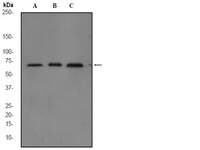04-1008 Sigma-AldrichAnti-NF-κ-B p65 Antibody, clone EP2161Y, rabbit monoclonal
Please note that this product will not be available for sale after March 15, 2015. Please select one of the other antibodies against this target.
More>> Please note that this product will not be available for sale after March 15, 2015. Please select one of the other antibodies against this target. Less<<Productos recomendados
Descripción
| Replacement Information |
|---|
Tabla espec. clave
| Species Reactivity | Key Applications | Host | Format | Antibody Type |
|---|---|---|---|---|
| H | WB, ICC, FC | Rb | Culture Supernatant | Monoclonal Antibody |
| References |
|---|
| Physicochemical Information |
|---|
| Dimensions |
|---|
| Materials Information |
|---|
| Toxicological Information |
|---|
| Safety Information according to GHS |
|---|
| Safety Information |
|---|
| Packaging Information | |
|---|---|
| Material Size | 100 µL |
| Transport Information |
|---|
| Supplemental Information |
|---|
| Specifications |
|---|
| Global Trade Item Number | |
|---|---|
| Número de referencia | GTIN |
| 04-1008 | 04053252338649 |
Documentation
Licencias necesarias
| Título |
|---|
| PRODUCTO REGULADO POR LA SECRETARÍA DE SALUD |
Anti-NF-κ-B p65 Antibody, clone EP2161Y, rabbit monoclonal Ficha datos de seguridad (MSDS)
| Título |
|---|
Anti-NF-κ-B p65 Antibody, clone EP2161Y, rabbit monoclonal Certificados de análisis
| Cargo | Número de lote |
|---|---|
| Anti-NF--B p65, clone EP2161Y, Rabbit Monoclonal - NG1628019 | NG1628019 |
| Anti-NF--B p65, clone EP2161Y, Rabbit Monoclonal - NG1876200 | NG1876200 |
| Anti-NF-κ-B p65, clone EP2161Y | 2476719 |












